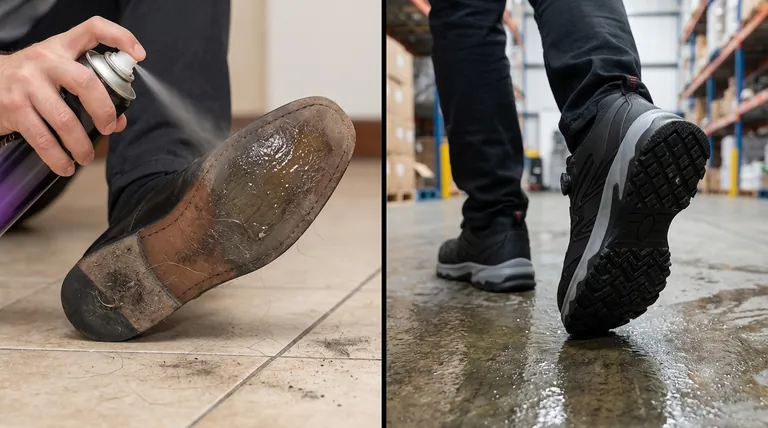In short, no. While applying hairspray to the bottom of your shoes can create a temporary feeling of stickiness, it does not provide true slip resistance and can make the situation more dangerous. The sticky residue quickly attracts dirt and dust, forming a smooth layer that can reduce traction and increase your risk of falling.
The core issue is the difference between stickiness and traction. Hairspray offers a fleeting, unreliable stickiness, while genuine safety requires durable, mechanical traction designed to grip surfaces and channel away moisture.

Why Hairspray Fails as a Slip-Resistant Solution
Understanding why this common "hack" is ineffective and potentially hazardous is crucial for making a safer choice. The mechanism of hairspray is fundamentally at odds with what makes a shoe sole effective.
The Illusion of Grip: Stickiness vs. Traction
True slip resistance is a function of friction. The material and tread pattern of a shoe's outsole are designed to create a high coefficient of friction against a walking surface, even when wet.
Hairspray, however, works through adhesion, creating a tacky surface. This stickiness is not the same as grip and offers no ability to channel away water or deal with uneven surfaces.
The Problem of Contamination
The stickiness of hairspray is its greatest weakness. As you walk, the soles of your shoes will immediately pick up dust, dirt, grime, and any other debris on the floor.
This collected material quickly covers the tacky layer, often creating a surface that is smoother and more slippery than the original sole.
A Lack of Durability
Any minor adhesive effect from hairspray is extremely temporary. It wears off within minutes of walking, especially on abrasive surfaces like concrete or pavement, leaving you with a false sense of security.
The Dangers of Unreliable DIY Fixes
While the temptation to find a quick, at-home solution is understandable, most DIY methods for shoe grip come with significant trade-offs that can compromise your safety.
Creating a False Sense of Security
The most significant danger is believing you have fixed the problem. Relying on an ineffective solution like hairspray might lead you to walk with less caution than you otherwise would, increasing the likelihood of a slip and fall.
Damaging Your Footwear
Applying chemicals like hairspray, sprays not intended for footwear, or adhesive mixtures can damage the sole material of your shoes. This can cause the rubber or synthetic compounds to degrade, crack, or become brittle over time.
Inconsistent and Unpredictable Results
DIY methods are, by nature, inconsistent. A technique that seems to work on a clean, dry floor may fail catastrophically on a wet, dusty, or greasy surface. Professional solutions are tested to perform reliably under various conditions.
How to Apply This to Your Goal
Instead of relying on ineffective quick fixes, choose a solution that matches your actual need for safety and durability.
- If your primary focus is a quick fix for a single event: Gently scuffing the soles of new, smooth-bottomed shoes with sandpaper is a more effective way to create immediate texture and grip.
- If your primary focus is improving a favorite pair of shoes for regular use: Purchase adhesive anti-slip pads designed for shoe soles or consult a cobbler about adding a thin, textured rubber outsole.
- If your primary focus is safety in a work or daily environment: The only reliable solution is to invest in footwear that is certified as slip-resistant.
Prioritize genuine safety and mechanical grip over temporary and unreliable chemical stickiness.
Summary Table:
| Solution | Effectiveness | Safety | Durability |
|---|---|---|---|
| Hairspray | Very Low | Dangerous (increases risk) | Minutes |
| Sandpaper Scuffing | Low-Medium | Moderate | Temporary |
| Adhesive Anti-Slip Pads | Medium-High | Good | Medium-Term |
| Certified Slip-Resistant Shoes | High | Excellent | Long-Term |
Don't compromise on safety with unreliable DIY fixes. As a large-scale manufacturer, 3515 produces a comprehensive range of certified slip-resistant footwear for distributors, brand owners, and bulk clients. Our professional-grade shoes and boots are engineered with durable outsoles and advanced tread patterns to provide reliable traction, protecting your workforce and customers. Contact our experts today to find the right safety footwear solution for your needs.
Visual Guide

Related Products
- Advanced KPU Athletic Safety Shoe with Steel Toe Cap Anti-Slip Rotary Lacing System
- Safety Footwear Wholesale Manufacturer for Custom OEM/ODM Production
- Premium Suede Sport Safety Shoes for Wholesale & Bulk Orders
- Wholesale Safety Footwear Manufacturer for Bulk & Custom OEM Orders
- Durable Rubber-Soled Utility Shoes for Wholesale & Custom Brand Manufacturing
People Also Ask
- What safety boots are recommended for the construction industry? Ensure Maximum Protection on the Job Site
- What are the advantages and disadvantages of steel toe boots? A Guide to Maximum Protection vs. Comfort
- What does the infographic mentioned in the article cover? Prevent Workplace Foot Injuries with the Right Safety Footwear
- What are the key safety features to consider when choosing work boots? Ensure Maximum Protection for Your Job
- What factors should be checked when trying on safety shoes? Ensure Perfect Fit & Maximum Protection



















